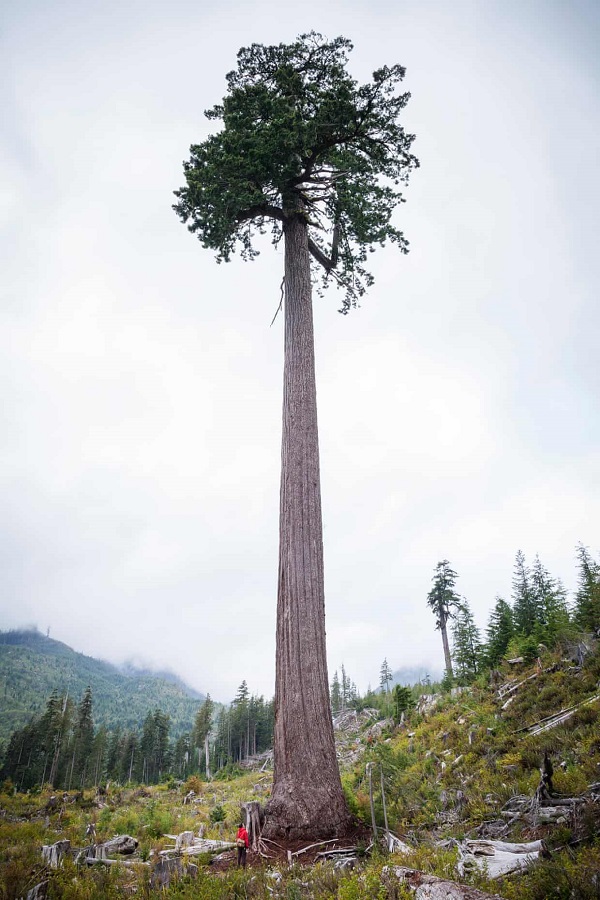“You can’t stay in your corner of the Forest waiting for others to come to you. You have to go to them sometimes.”
A.A. Milne, Winnie-the-Pooh
Month: May 2019
Tree of the Month: Big Lonely Doug

From The Walrus:
As he waded through the thigh-high undergrowth, something caught his attention: a Douglas fir, poking up through the forest’s canopy and with a trunk wider than his truck. It was one of the tallest trees he had ever come across in his four decades in the logging industry—nearly the height of a twenty-storey building.
From The Guardian:
The tree dominated the forest – a monarch of its species. Its crown of dark green, glossy needles flitted in the breeze well above the canopy of the forest. Like many of the oldest Douglas firs he had come across in his career, the tree’s trunk was limbless until a great height. The species often loses the lower branches that grow in the shadow of the forest’s canopy. Many of these large and old Douglas firs have clear marks of disease, with trunks that are twisted and gnarled. This tree’s trunk sported few knots and a grain that appeared straight: it was a wonderful specimen of timber, Cronin thought.
Particle Swarm

The instructions consisted of three equations, the first indicating the basal area at which the stand should be thinned, the second showing the optimal thinning intensity, and the third model indicating the mean diameter of trees at the moment of clear-felling. Particle swarm optimization (PSO) was employed to simultaneously optimize the coefficients of these three equation models. PSO maximized the average net present value of the management schedules of 29 larch sample plots.
More on particle swarm optimization here.
Trail Trees

From Atlas Obscura:
The trees looked like that, he was told, because native tribes had purposefully shaped them to mark trails through the woods and across the water. “Having the knowledge of these trail trees could mean the difference between life and death, between eating and starving, between crossing the river correctly or incorrectly,” he says.
From The Scientific Monthly (pdf):
It has been found that various methods of securing the saplings in position were used, depending on the materials at hand and the custom or ingenuity of the individual performing the task. Sometimes the trees, after being bent, were weighted down with a rock if one could be found nearby. Occasionally they were staked; sometimes a pile of dirt was used. But more frequently the trees were tied in position with a strip of rawhide, bark or tough vine. In each case the trees were fastened so that the direction of bend was parallel to the direction of the trail to be followed. Each tree was thus a pointer directed toward, or away from, the next marker in the. trail.
Logging Train

- Title: Washington logging train going down a mountain, on which are logs from a fir tree 12 feet in diameter
- Date Created/Published: c1908.
- Medium: 1 photographic print.
Mangroves

From NASA:
The maps on this page, based on data from Simard and colleagues, depict the canopy height—the average height of the trees—around the Gabon Estuary in Africa and around Bintuni Bay in Indonesia. The muddy, fertile swamps of Gabon nurture the world’s tallest mangroves, with the loftiest tree (65 meters, or 213 feet) overtopping the Grizzly Giant sequoia of Yosemite National Park.
Jurassic Park for Trees
From Quartz:
Imagine scientists reviving giant creatures that once roamed the Earth. Well, that’s what arborists are doing today, only they’re cloning saplings from the stumps of the world’s largest, strongest, and longest-lived trees—felled for timber more than a century ago—to create redwood “super groves” that can help fight climate change.
Columbus and Reforestation

From ScienceDirect: (pdf)
We estimate that 55 million indigenous people died following the European conquest of the Americas beginning in 1492. This led to the abandonment and secondary succession of 56 million hectares of land…These changes show that the Great Dying of the Indigenous Peoples of the Americas is necessary for a parsimonious explanation of the anomalous decrease in atmospheric CO2 at that time and the resulting decline in global surface air temperatures…We conclude that the Great Dying of the Indigenous Peoples of the Americas led to the abandonment of enough cleared land in the Americas that the resulting terrestrial carbon uptake had a detectable impact on both atmospheric CO2 and global surface air temperatures in the two centuries prior to the Industrial Revolution.
The Lumber Yard
From The Daily Overview:

Nontimber Forest Products – Africa edition
From the FAO:
In Africa, trees provide a wealth of products and services that are essential to people living in or around forest areas. Even in the driest regions, there are valuable trees like the acacia that can be tapped as sources of raw materials. Acacia in particular produces gum arabic, which is widely used by the food industry, and Balanites, a desert tree indigenous to Africa, that produces oil that can be used for cooking, cosmetics, and soap.